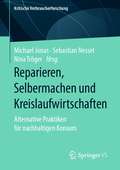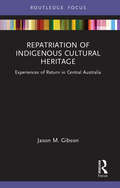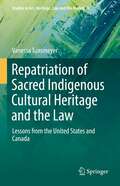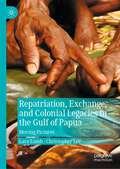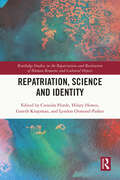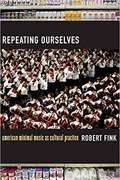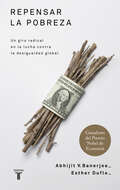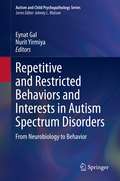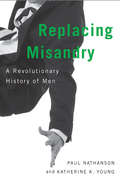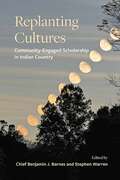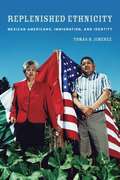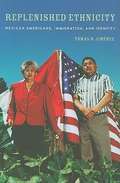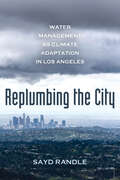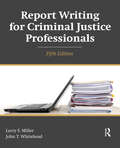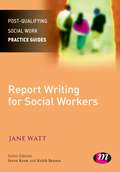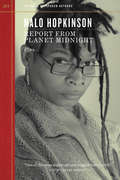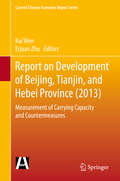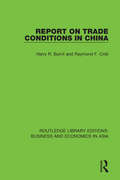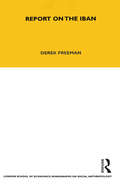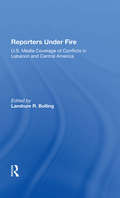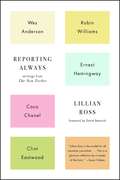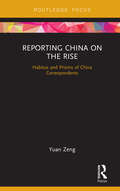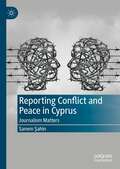- Table View
- List View
Reparieren, Selbermachen und Kreislaufwirtschaften: Alternative Praktiken für nachhaltigen Konsum (Kritische Verbraucherforschung)
by Michael Jonas Nina Tröger Sebastian NesselRepair & Do-It-Yourself Aktivitäten auf der einen Seite und Diskussionen über die Kreislaufwirtschaft auf der anderen Seite gelten aktuell als vielversprechende Beispiele, wie derzeitige Konsumtions- und Produktionsweisen im Sinne einer nachhaltigen Gesellschaft reorganisiert und umgestaltet werden können. Der Band diskutiert sowohl aus wissenschaftlicher als auch aus praxisbezogener Perspektive die Relevanz, die Wechselwirkungen wie auch die Möglichkeiten und Grenzen der genannten Phänomene des Reparierens, Selbermachens und Länger Nutzens einerseits und des Kreislaufwirtschaftens andererseits.
Repatriation of Indigenous Cultural Heritage: Experiences of Return in Central Australia (Museums in Focus)
by Jason M. GibsonRepatriation of Indigenous Cultural Heritage examines how returned materials - objects, photographs, audio and manuscripts - are being received and reintegrated into the ongoing social and cultural lives of Aboriginal Australians. Combining a critical examination of the making of these collections with an assessment of their contemporary significance, the book exposes the opportunities and challenges involved in returning cultural heritage for the purposes of maintaining, preserving or reviving cultural practice. Drawing on ethnographic work undertaken with Aboriginal communities and the institutions that hold significant collections, the author reveals important new insights about the impact of return on communities. Technological advances, combined with the push towards decolonising methodologies in Indigenous research, have resulted in considerable interest in ensuring that collections of cultural value are returned to Indigenous communities. Gibson challenges the rhetoric of museum repatriation, arguing that, while it has been tremendously important to advancing Indigenous interest, it is too often over-simplified. Repatriation of Indigenous Cultural Heritage offers a timely, critical perspective on current museum practice and its place within processes of cultural production and transmission. The book is sure to resonate in other international contexts where questions about Indigenous re-engagement and decolonisation strategies are being debated and will be of interest to students and scholars of Museum Studies, Indigenous Studies and Anthropology.
Repatriation of Sacred Indigenous Cultural Heritage and the Law: Lessons from the United States and Canada (Studies in Art, Heritage, Law and the Market #3)
by Vanessa TünsmeyerThis book examines the ways in which law can be used to structure the return of indigenous sacred cultural heritage to indigenous communities, referred to as repatriation in this volume. In particular, it aims at developing legal structures that align repatriation with contemporary international human rights standards. To do so, it gathers the most valuable lessons learned from different repatriation laws and frameworks adopted in the United States and Canada. In both countries, very different ways of approaching repatriation have been used for several decades, highlighting the context-dependent nature of repatriation. The volume is divided into four parts, looking first at international law, then at the national legal landscape in the United States, followed by Canada, before the different repatriation models are evaluated against the backdrop of human rights law standards. Emphasis is placed not only on repatriation-specific legislation but also on the legal context in which it was developed and operates. In turn, the fourth part develops various models on the basis of these experiences that can be aligned with contemporary indigenous and cultural rights. The book ends by considering the models’ suitability for international repatriation and the lessons that can be learned from them. The primary audience includes those addressing the legal hurdles to repatriation, be they researchers, policymakers, communities, or museums.
Repatriation, Exchange, and Colonial Legacies in the Gulf of Papua: Moving Pictures
by Christopher Lee Lara LambThis book explores the people of the Kikori River Delta, in the Gulf of Papua, as established historical agents of intercultural exchange. One hundred years after they were made, Frank Hurley’s colonial-era photographic reproductions are returned to the descendants of the Kerewo and Urama peoples, whom he photographed. The book illuminates how the movement, use, and exchange of objects can produce distinctive and unrecognised forms of value. To understand this exchange, a nuanced history of the conditions of the exchange is necessary, which also allows a reconsideration of the colonial legacies that continue to affect the social and political worlds of people in the twenty-first century.
Repatriation, Science and Identity (Routledge Studies in the Repatriation and Restitution of Human Remains and Cultural Objects)
by Gareth Knapman Cressida Fforde Hilary Howes Lyndon Ormond-ParkerRepatriation, Science, and Identity explores the entanglement of race, history, identity and ethics inherent in the application of scientific techniques to determine the provenance of Indigenous Ancestral Remains in repatriation claims and processes. The book considers how these issues relate to collections of Indigenous Ancestral (bodily) Remains but also their resonance with emerging concerns about the relatively unknown history of scientific interest in Indigenous hair and blood samples. It also explores the more recent practice of sampling for the purposes of DNA analysis and issues concerning the data that has been produced from all of the above types of research. Placing recent interest in applying scientific techniques to repatriation in their historical context, it enables discourses of identity and scientific authority, an assessment of their efficacy and an exploration of ethical and practical challenges and opportunities. In doing so, this book reveals new histories about scientific interest in Indigenous biology and the collections that resulted, as well as providing reflection for all repatriation practitioners considering scientific investigation when faced with the challenges inherent in the repatriation of unprovenanced or poorly provenanced Ancestral Remains. Providing the reader with a means to approach the value, or otherwise, of the scientific information they may encounter, Repatriation, Science, and Identity is an invaluable resource for researchers and professionals working with Indigenous Ancestral Remains.
Repealing the 8th: Reforming Irish abortion law
by Fiona De Londras Mairead EnrightAvailable Open Access under CC-BY licence. Irish law currently permits abortion only where the life of the pregnant woman is at risk. Since 1983, the 8th Amendment to the Constitution has recognised the “unborn” as having a right to life equal to that of the “mother”. Consequently, most people in Ireland who wish to bring their pregnancies to an end either import the abortion pill illegally, travel abroad to access abortion, or continue with the pregnancy against their will. Now, however, there are signs of change. A constitutional referendum will be held in 2018, after which it will be possible to reimagine, redesign, and reform the law on abortion. Written by experts in the field, this book draws on experience from other countries, as well as experiences of maternal medical care in Ireland, to call for a feminist, woman-centered, and rights-based radical new approach to abortion law in Ireland. Directly challenging grounds-based abortion law, this accessible guide brings together feminist analysis, comparative research, human rights law, and political awareness to propose a new constitutional and legislative settlement on reproductive autonomy in Ireland. It offers practical proposals for policymakers and advocates, including model legislation, making it an essential campaigning tool leading up to the referendum.
Repeating Ourselves: American Minimal Music as Cultural Practice
by Robert FinkWhere did musical minimalism come from―and what does it mean? In this significant revisionist account of minimalist music, Robert Fink connects repetitive music to the postwar evolution of an American mass consumer society. Abandoning the ingrained formalism of minimalist aesthetics, Repeating Ourselves considers the cultural significance of American repetitive music exemplified by composers such as Terry Riley, Steve Reich, and Philip Glass. Fink juxtaposes repetitive minimal music with 1970s disco; assesses it in relation to the selling structure of mass-media advertising campaigns; traces it back to the innovations in hi-fi technology that turned baroque concertos into ambient "easy listening"; and appraises its meditative kinship to the spiritual path of musical mastery offered by Japan's Suzuki Method of Talent Education.
Repensar la pobreza: Un giro radical en la lucha contra la desigualdad global
by Abhijit Banerjee Esther DufloEsther Duflo y Abhijit Banerjee, ganadores del Premio Nobel de Economía 2019. El libro que cambiará nuestra manera de pensar sobre la pobreza y lo que debemos hacer para aliviarla. ¿Cómo se vive con menos de un dólar al día? ¿Por qué los microcréditos resultan útiles pero no son el milagro que algunos esperaban? ¿Por qué los pobres dejan pasar las campañas de vacunación gratuita pero pagan por medicinas que a menudo no necesitan? ¿Por qué sus hijos pueden ir a la escuela año tras año y no aprender nada? ¿Por qué no siempre invierten en obtener más calorías, sino calorías que saben mejor? Nuestra tendencia a reducir a los pobres a un conjunto de clichés nos ha impedido hasta ahora comprender los problemas a los que se enfrentan a diario. Dado que poseen tan poco, hemos asumido que no hay nada de interés en su vida económica. Las políticas gubernamentales destinadas a ayudarles muchas veces fracasan porque se fundamentan en suposiciones erradas con respecto a sus circunstancias y su conducta. Repensar la pobreza supone un revolucionario giro en el modo de abordar la lucha global contra la pobreza. Sus autores, dos consagrados economistas del MIT, han acudido directamente a los protagonistas para comprender cómo funciona de verdad la economía de los pobres, cuáles son sus motivaciones y aspiraciones. Los resultados de sus observaciones contradicen muchas de nuestras creencias más arraigadas. El innovador planteamiento de este libro empieza por cambiar las preguntas. A partir de ahí, ofrece las respuestas y, con ellas, un gran potencial transformador y una guía esencial para políticos, activistas y cualquier persona preocupada por construir un mundo sin desigualdad. Reseñas:«Un libro maravillosamente lúcido sobre la naturaleza real de la pobreza.»Amartya Sen, Premio Nobel de Economía «El ensayo más interesante que he leído en mucho tiempo. Está lleno de sorpresas y va a cambiar nuestra manera de pensar sobre la pobreza y lo que se debe hacer para aliviarla.»Moisés Naím en «Lea este libro», El País «Este libro debe ser de lectura obligada para cualquier persona que se preocupe por la pobreza en el mundo. Representa lo mejor que la economía puede ofrecer.»Steven D. Levitt, autor de Freakonomics «Vayamos al grano: es el mejor libro que he leído sobre el tema.No hay truco. El enfoque es directo y honesto. Y algunas de las conclusiones son sorprendentes, incluso desconcertantes.»The Economist «Un logro profundo: reúne lo mejor de la nueva economía y de la antigua. Se han sumergido en el mundo que los rodea, negándose a aceptar la idea de que la economía es unamera extensión de las matemáticas.»David Leonhardt, The New York Times «Maravilloso. Han luchado por conquistar, con honestidad y rigor, un puesto de avanzada hacia la observación, el análisis y la complejidad en un mundo, el de la ayuda, que tiende a preferir los panfletos y las fotografías de famosos. Merecen ser felicitados y leídos.»William Easterly, The Wall Street Journal
Repetitive and Restricted Behaviors and Interests in Autism Spectrum Disorders: From Neurobiology to Behavior (Autism and Child Psychopathology Series)
by Nurit Yirmiya Eynat GalThis volume examines repetitive and restrictive behaviors and interests (RRBIs) affecting individuals with autism spectrum disorder (ASD). The various aspects of RRBIs, an umbrella term for a broad class of behaviors linked by repetition, rigidity, invariance, and inappropriateness to place and context are reviewed by an international team of expert leaders in the field. Key topics of coverage include:Neurological Mechanisms Underlying Repetitive: Animal and human modelsUnderlying mechanisms of RRBs across typical and atypical developmentThe relationship between RRBI and other characteristics of ASD (communication, social, sensory aspects) RRBIs and adults with ASDDiagnosing RRBIs An RRBI intervention modelThe book bridges the gap between the neurobiological and neurocognitive bodies of knowledge in relation to RRBIs and their behavioral aspects and examines associations with other domains of ASD. In addition, the volume addresses related assessment and treatment of RRBI in ASD. This is an essential resource for researchers, graduate students, clinicians and related therapists and professionals in developmental psychology, behavioral therapy/rehabilitation, social work, clinical child and school psychology, child and adolescent psychiatry, pediatrics, occupational therapy and special education.
Replacing Misandry: A Revolutionary History of Men
by Katherine K. Young Paul NathansonIn the first three volumes of this series, Paul Nathanson and Katherine Young challenge theories about patriarchy that ideological forms of feminism have promoted.<P><P> In this volume, they argue that we must replace those misandric theories with one that takes seriously the needs and problems of boys and men no less than those of girls and women; at the same time, they add, we must maintain the reforms that egalitarian forms of feminism have promoted. With both factors in mind, they trace the history of men - that is, culturally organized perceptions of the male body and its masculine functions - over the past ten thousand years. They show how these perceptions have evolved in connection with a series of technological and cultural revolutions: horticultural, agricultural, industrial, military, and now reproductive. This new approach sets the stage for understanding a profound and growing problem that our society must face: the increasing inability of boys and men to create or sustain a healthy collective identity. The authors define this as an identity that is distinctive, necessary, and therefore publicly valued. Without a healthy and positive identity, two current trends will continue: giving up (dropping out of school, society, or even life itself) and attacking a society that has no room for men specifically as men, believing that even a negative identity, acted out in antisocial ways, is better than none at all.
Replanting Cultures: Community-Engaged Scholarship in Indian Country (SUNY series, Tribal Worlds: Critical Studies in American Indian Nation Building)
by Chief Benjamin J. Barnes; Stephen WarrenReplanting Cultures provides a theoretical and practical guide to community-engaged scholarship with Indigenous communities in the United States and Canada. Chapters on the work of collaborative, respectful, and reciprocal research between Indigenous nations and colleges and universities, museums, archives, and research centers are designed to offer models of scholarship that build capacity in Indigenous communities. Replanting Cultures includes case studies of Indigenous nations from the Stó:lō of the Fraser River Valley to the Shawnee and Miami tribes of Oklahoma, Ohio, and Indiana. Native and non-Native authors provide frank assessments of the work that goes into establishing meaningful collaborations that result in the betterment of Native peoples. Despite the challenges, readers interested in better research outcomes for the world's Indigenous peoples will be inspired by these reflections on the practice of community engagement.
Replenished Ethnicity
by Tomás R. JiménezUnlike the wave of immigration that came through Ellis Island and then subsided, immigration to the United States from Mexico has been virtually uninterrupted for one hundred years. In this vividly detailed book, Tomas R. Jimenez takes us into the lives of later-generation descendents of Mexican immigrants, asking for the first time how this constant influx of immigrants from their ethnic homeland has shaped their assimilation. His nuanced investigation of this complex and little-studied phenomenon finds that continuous immigration has resulted in a vibrant ethnicity that later-generation Mexican Americans describe as both costly and beneficial. "Replenished Ethnicity" sheds new light on Americas largest ethnic group, making it must reading for anyone interested in how immigration is changing the United States.
Replenished Ethnicity: Mexican Americans, Immigration, and Identity
by Tomás R. JiménezThis book shows how the ethnic identity formation of later-generation Mexican Americans is shaped by ongoing immigration, while also considering the factors that other research has identified as central to the Mexican-origin experience: race, class, a history of colonization, the proximity of the border.
Replumbing the City: Water Management as Climate Adaptation in Los Angeles
by Sayd RandleMoving between shower drains, aqueducts, rain gardens, and even kitchen sinks, Replumbing the City traces the enormous urban waterscape of Los Angeles in a state of flux. For more than a century, the city of Los Angeles has relied on faraway water for the vast majority of its municipal supply, but climate change is making these distant sources much less dependable. To adapt, Angelenos—including city engineers, advocates at NGOs, and residents—are developing new water supplies within the space of the city. Sayd Randle’s ethnography examines the labor of replumbing LA’s sprawling water system, detailing how a desire to sustain unlimited and uninterrupted water provision for paying customers is reshaping the urban environment and its management. Tracking how such projects redistribute the work of water management, the book explores thorny questions of how the labor of climate adaptation should be mobilized and valued.
Report Writing for Criminal Justice Professionals
by John T. Whitehead Larry S. MillerThe criminal justice process is dependent on accurate documentation. Criminal justice professionals can spend 50-75% of their time writing administrative and research reports. Report Writing for Criminal Justice Professionals, Fifth Edition provides practical guidance--with specific writing samples and guidelines--for providing strong reports. Much of the legal process depends on careful documentation and the crucial information that lies within, but most law enforcement, security, corrections, and probation and parole officers have not had adequate training in how to provide well-written, accurate, brief, and complete reports. Report Writing for Criminal Justice Professionals covers everything officers need to learn--from basic English grammar to the difficult but often-ignored problem of creating documentation that will hold up in court. This new edition is updated to include timely information, including extensive coverage of digital reporting, updates on legal issues and privacy rights, and expanded coverage of forensics and scientific reporting.
Report Writing for Social Workers (Post-Qualifying Social Work Practice Guides)
by Jane WattMany students and qualified workers in all areas of social work feel apprehension at the prospect of writing a formal report for a court or tribunal. Writing may be a fundamental skill, but it is one that students and practitioners cannot afford to take for granted. Recent reviews (Baby P, Serious Case Review processes) highlighted the need for clear reports, recording and written communication between professionals. This practical and accessible textbook presents the report writing process in a clear and straightforward way. From methods of collecting and presenting evidence, to drawing conclusions and writing up a final report.
Report from Planet Midnight (Outspoken Authors)
by Nalo HopkinsonInfused with feminist, Afro-Caribbean views of the science fiction and fantasy genres, this collection of offbeat and highly original works takes aim at race and racism in literature. In "Report from Planet Midnight," at the International Association of the Fantastic in the Arts, an alien addresses the crowd, evaluating Earth's "strange" customs, including the marginalization of works by nonwhite and female writers. "Message in a Bottle" shows Greg, an American Indian artist, befriending a strange four-year-old who seems wise beyond her years. While preparing an exhibition, he discovers that the young girl is a traveler from the future sent to recover art from the distant past—which apparently includes his own work. Concluding the book with series editor Terry Bisson's Outspoken Interview, Nalo Hopkinson shares laughs, loves, and top-secret Caribbean spells.
Report of an Inquiry into an Injustice: Begade Shutagot'ine and the Sahtu Treaty (Contemporary Studies on the North #5)
by Peter Kulchyski"A Report of an Inquiry into an Injustice" chronicles Peter Kulchyski’s experiences with the Begade Shutagot’ine, a small community of a few hundred people living in and around Tulita (formerly Fort Norman), on the Mackenzie River in the heart of Canada’s Northwest Territories. Despite their formal objections and boycott of the agreement, the band and their lands were included in the Sahtu Treaty, a modern comprehensive land claims agreement negotiated between the Government of Canada and the Sahtu Tribal Council, representing Dene and Metis peoples of the region. While both Treaty 11 (1921) and the Sahtu Treaty (1994) purport to extinguish Begade Shutagot'ine Aboriginal title, oral history and documented attempts to exclude themselves from treaty strongly challenge the validity of that extinguishment. Structured as a series of briefs to an inquiry into the Begade Shutagot’ine’s claim, this manuscript documents the negotiation and implementation of the Sahtu Treaty and amasses evidence of historical and continued presence and land use to make eminently clear that the Begade Shutagot'ine are the continued owners of the land by law: they have not extinguished title to their traditional territories; they continue to exercise their customs, practices, and traditions on those territories; and they have a fundamental right to be consulted on, and refuse or be compensated for, development projects on those territories. Kulchyski bears eloquent witness to the Begade Shutagot'ine people's two-decade struggle for land rights, which have been blatantly ignored by federal and territorial authorities for too long.
Report on Development of Beijing, Tianjin, and Hebei Province
by Kui Wen Erjuan ZhuThis book mainly focuses on the status, trends and countermeasures of carrying capacity in the Beijing-Tianjin-Hebei metropolitan region. It presents the results a comprehensive survey and systematic research on the carrying capacity of this region and its mega-cities, conducted in the hope of providing decision-making support for the governments of this region. The primary goals are to be able to actively respond to the new challenges of global climate changes and environmental resource constraints; fully practice green development concepts; and actively promote transformation in the development of the population, resources, environment, economics, society and ecology in this region.
Report on Trade Conditions in China (Routledge Library Editions: Business and Economics in Asia #29)
by Harry R. Burrill Raymond F. CristThis study, first published in 1906, examines the position of the United States in the markets of the Chinese Empire and the steps necessary to insure a greater development of American commerce in the Far East.
Report on the Iban: Volume 41 (LSE Monographs on Social Anthropology)
by Derek FreedmanThe Iban or the Sea Dayaks of Sarawak have probably been the best known of the indigenous peoples of Borneo for well over a century. Much has been written about them, but until the results of Dr Freeman's field research were published by the Government of Sarawak and by Her Majesty's Stationery Office in 1955 there was little information on their methods of agriculture and their social system. The book has become a landmark in the studies of shifting cultivation and of cognatic kinship organization; and the ideas around which it is written have proved over the years to be a continuing and powerful stimulus in the development of kinship theory. The field work on which the account is based was undertaken from 1949 to 1951. Although fundamental changes have taken place in the life of the Iban since the book was first published, it has been decided to republish it substantially unaltered.
Reporters Under Fire: U.s. Media Coverage Of Conflicts In Lebanon And Central America
by Landrum R BollingNews media professionals, especially those covering political events or wars, are often accused of distorting the news or presenting biased and superficial analyses. Coverage of the recent conflicts in Central America and the Middle East has been especially controversial. In this volume, which is based on a series of seminars sponsored by the Institute for the Study of Diplomacy at Georgetown University, experienced journalists and media critics assess the complaints about coverage and the defenses the media marshall against those complaints. They explore the dilemmas that democratic societies face in trying to preserve traditional freedom of expression while pursuing political goals in ways that may involve the use of force. By analyzing the political impact of television coverage of battlefield scenes and the practical limitations and difficulties under which the media must work, the authors illuminate the powerful role of the media in the shaping of American politics, including diplomatic and military policies.
Reporting Always: Writings from The New Yorker
by Lillian Ross David RemnickFrom the inimitable veteran New Yorker journalist Lillian Ross--a stunning collection of Ross's iconic New Yorker pieces.A staff writer for The New Yorker since 1945, Lillian Ross is one of the few journalists who worked for both the magazine's founding editor, Harold Ross, and its current editor, David Remnick. Ross invented the entertainment profile. She was the first person to write journalism in "scenes" as novelists do, and her profiles are full of humor and details that bring her subjects alive on the page. Her style has been studied and imitated by numerous writers. But there is only one Lillian Ross: spirited, funny, factual, and unforgettable. Reporting Always collects a wide range of Lillian Ross's New Yorker articles and "Talk of the Town" pieces spanning sixty years, bringing readers into Robin Williams's living room; Harry Winston's office; the afterschool hangouts of Manhattan private-school children; the hotel rooms of Ernest Hemingway, John Huston, and Charlie Chaplin; onto the tennis court with John McEnroe; and into the lives of many other famous and not-so-famous characters. Ross's portraits are filled with rich details that reveal her subjects in amusing and perceptive ways. A foreword by David Remnick discusses Ross's trademark style and her important place in the history of The New Yorker.
Reporting China on the Rise: Habitus and Prisms of China Correspondents (Routledge Focus on Communication and Society)
by Yuan ZengDrawing on the structural-constructivist framework of journalistic field and habitus, Reporting China on the Rise examines the internal and external dynamics which are shaping the work of foreign correspondents in China during Xi Jinping’s tenure. This study presents findings from extensive surveys and interviews with current and former correspondents based in China. It aims to explore how they have responded, and continue to respond, to pressures from within the journalistic field (such as a transforming media industry), as well as from constant shifts in global geopolitics, and China’s increasingly restrictive journalistic environment. These factors are shown to work together to relationally define the news production practice of these correspondents and, ultimately, shape the final news product. Journalism in modern China has become a widely discussed, yet gravely under-researched topic, both for policy-makers and academics. Reporting China on the Rise seeks to open up discussions around the role of the foreign press in generating meaningful media coverage of this growing superpower. It will be an invaluable resource for students and researchers of Journalism and Media Studies.
Reporting Conflict and Peace in Cyprus: Journalism Matters
by Sanem ŞahinThis book studies journalism in Cyprus to understand how journalists negotiate their roles and responsibilities in conflict-affected societies. In Cyprus, journalism has navigated through the pressures and challenges of intercommunal and political tensions. The book outlines a historical context of the conflict, also known as the Cyprus problem and discusses the news media's involvement in it. However, the primary concern is journalists' perceptions of their professional roles and external forces affecting their work. It examines the impact of political, economic and organisational influences, media ownership and technological developments on their work through interviews conducted with journalists. It studies professional and ethical challenges journalists experience, especially when reporting intercommunal relations. Finally, it explores the impact of digital media on journalism and the public debate on the Cyprus problem.
